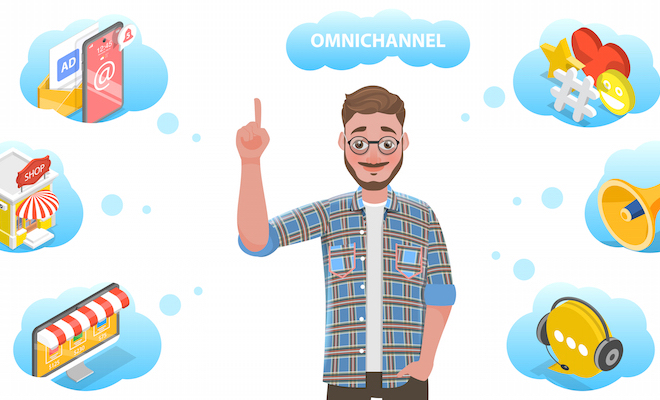It’s no secret that the essential technology behind e-commerce pulled our world (albeit kicking and screaming) through 2020.
Though the pandemic isn’t over yet in 2021, each day we get one step closer to the world returning to “normal…” ish. Some things (such as hugging family and friends, in-person celebrations, and no longer needing to stock up on toilet paper) we can’t wait to enjoy like we did in 2020, but many aspects of our lives and businesses have been permanently changed for the better.
And yes, we are talking about the online platforms for your business! Though brick and mortar operations will be back in some form, having a streamlined, integrated e-commerce experience for your business will be essential in moving forward and getting ahead of your competition.
That’s why we want to introduce you to your new best friend that will revolutionize your online sales game for the future: meet the omni channel marketing strategy.
What is an omni channel marketing strategy?
Before showing you how to use technology to create an omni channel strategy that boosts sales, let’s unpack what an omni channel strategy is and how 2020 sped up the timeline for this innovative approach.
Omni channel strategy is the process of using multiple channels to create a seamless, integrated experience with your customers at every stage of your operational process, from marketing to selling to serving, etc. Essentially, it’s the intentional streamlining of any and every process where your customers engage with your business so that they’ll have the same experience with your company whether they call you, message you, email you, tweet you, or walk into your store.
Though omni channel strategy may not sound groundbreaking or innovative (and instead more like common sense), it’s actually very difficult for companies to create a streamlined, integrated omni channel strategy setup. The reality is, most companies stop at creating a multi channel marketing strategy where they have multiple avenues for communicating with customers, collecting payment, and providing goods and services, but those avenues are far from integrated.
Does an omni channel strategy really revolutionize sales?
It’s easy to dismiss an omni channel strategy as nice but unnecessary when it comes to generating sales. However, when we look at the behavioral trends of consumers (provided by Marketing Week) that were only intensified by the circumstances of 2020, here’s why an omni channel strategy is the key to a strong sales strategy.
15 years ago, the average consumer only needed two points of engagement with a company — aka touch points — when purchasing an item or service. (Quick note: Touch points can refer to any customer engagement such as initial communication, asking questions, or customer service.) Overall, only 7% of consumers needed more than four touch points while purchasing goods and services, meaning that the vast majority of customers didn’t need much engagement with a company or multiple channels of doing so in order to buy from them. The average consumer was ready to purchase when they started the process.
Now the average consumer requires at least six touch points before purchasing, with a minimum of 50% of consumers requiring more than four touch points in order to make a purchase. This means that customers aren’t necessarily ready to purchase as soon as they encounter your company or when they start the buying process through one of your available channels!
Instead, they’re feeling you out.
Here’s an omni channel example to demonstrate:
Of course, statistics are great for providing data that gives companies actionable steps they can implement for their business, but to drive this point home, here’s a concrete example of how an omni channel strategy (or a lack thereof) makes or breaks a sale in real time:
Kari’s scrolling through Instagram and comes across an engaging video for a product she’s interested in. She taps the link to the company’s website and quickly adds items to her cart, but one product has a customization option that isn’t displaying correctly at check out. She pulls out her laptop to chat with customer service with the convenience of a keyboard, but realizes that chatting with support is only available by downloading the company’s app. She doesn’t want to wait for the download or type on her phone, so she closes her laptop and goes about her day.
Create a seamless omni channel process flow
Now that you’ve seen the value of an omni channel strategy, here’s how to create a seamless omni channel process flow using technology.
Know your audience and make the process as frictionless as possible.
First and foremost, before you create an omni channel strategy, you need to know who your target audience is to determine what channels of engagement are most effective for creating multiple touch points with your company.
Automate as many processes as possible.
Some companies are wary of losing close-knit customer relationships when automating aspects of their businesses, but the more operational processes you automate, the more you’re actually freed up to engage in genuine customer interaction.
Here are great processes to automate:
- Order alerts: Confirmation, processing, delays, shipment, tracking, and delivery.
- Shipping labels and tracking.
- Payment options: Contactless payments, virtual payments, payment portals, etc.
- Communication: Stay aware of the information you, your sales team, and customer services departments are frequently repeating and create several pieces of ever-green content that can communicate that information for you. FAQ pages, how-to videos, and on-brand automated responses are great examples of this!
- Securely stored customer information: Recent purchases, checkout information, etc. This step can be very tricky to navigate securely, and you always want to give customers up-front knowledge that their information will be saved or provide an opt-out option.
Walk the walk of your omni channel process yourself
… before it’s reported as a problem! It’s much better for you to find out the holes in your processes and patch them before your customers report them as a problem. We recommend that you set up a consistent process for periodically walking through the customer experiences created by your omni channel strategy.
If you want to ensure you have the right network infrastructure to create a revenue-driving omni channel strategy, we’ve built our to allow you the flexibility of integrating scalable tech to your business without the up-front cost.



